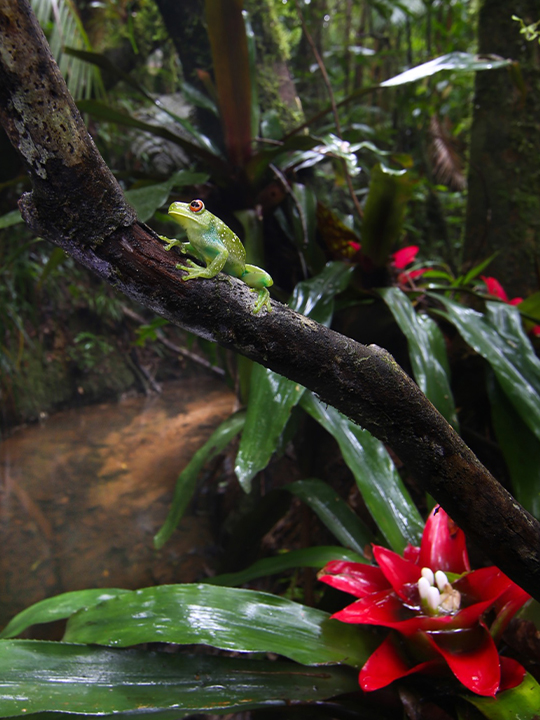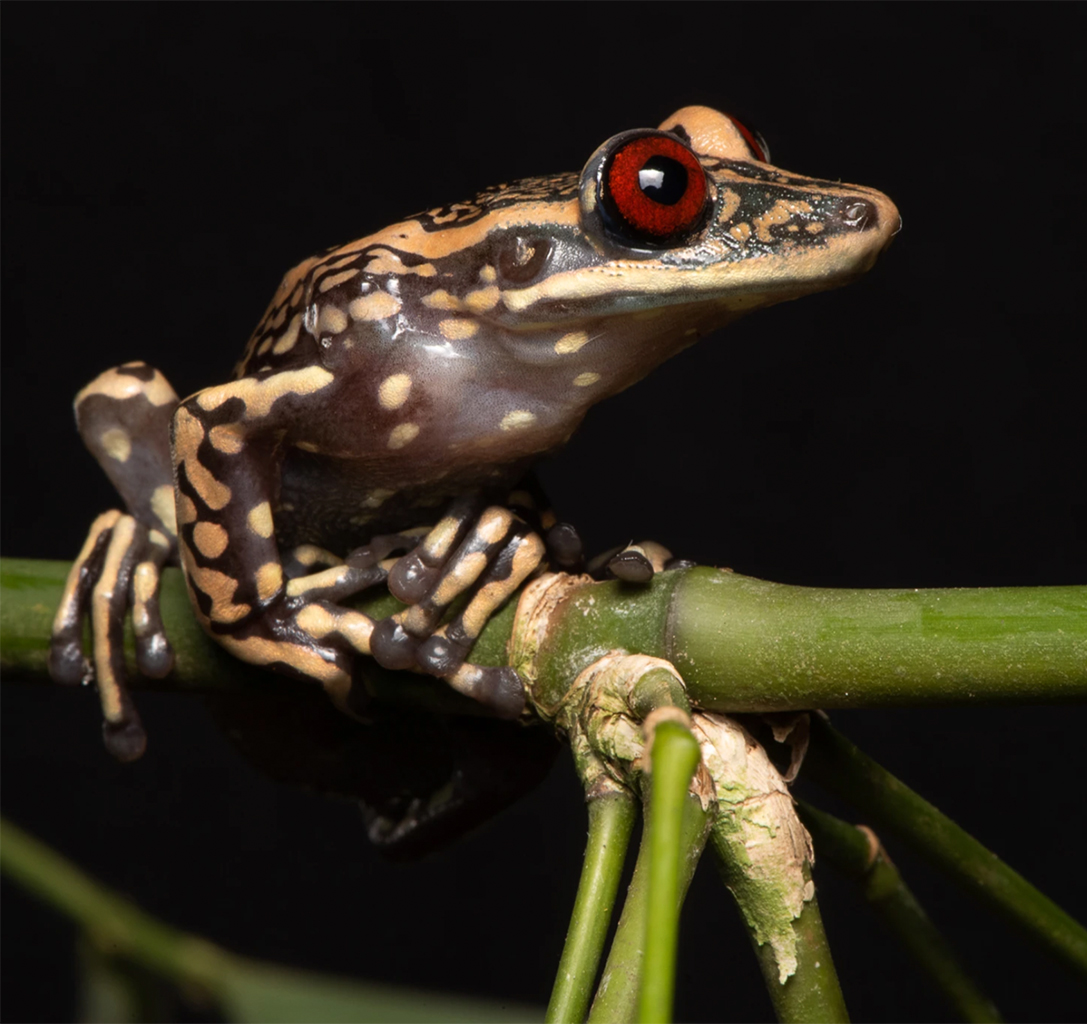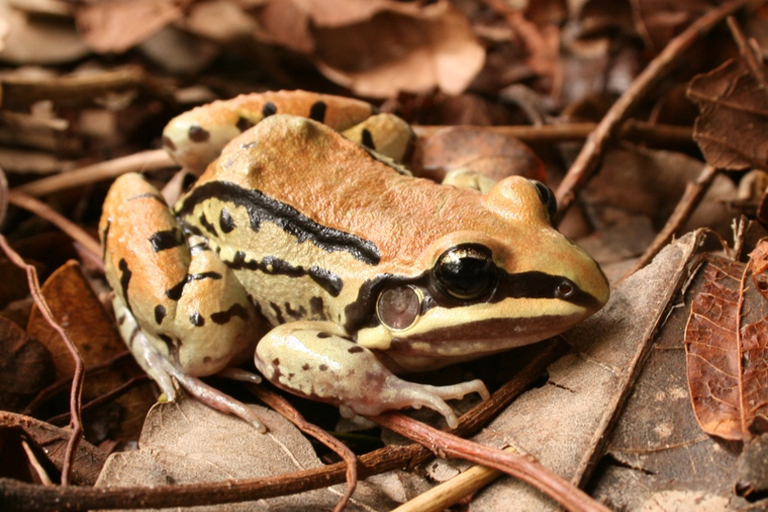- Amphibians across the tropics are facing a global decline, with disease caused by the chytrid fungus Batrachochytrium dendrobatidis (Bd) playing an especially significant role in losses.
- According to recent research, “habitat split” — when different types of habitat, such as terrestrial and freshwater areas, become separated — could play a role in exacerbating disease, potentially altering species’ microbiomes and weakening amphibian resistance.
- According to the study, an amphibian’s journey through altered habitat to complete its life cycle can change the composition of its microbiome (the bacterial makeup of the skin); induce chronic stress; and reduce immune gene diversity — all of which can impact disease resistance.
- Though further studies are needed, this research may offer another persuasive reason to actively restore and reconnect habitats, helping to “prime” amphibian immune systems against disease. There is also a possibility that habitat split findings among amphibians could extend to other families of animals.
As a precipitous global biodiversity decline escalates, forests across the tropics are increasingly becoming fragmented. This fragmentation can lead to multiple problems, including a process known as “habitat split” that could have consequences for disease among amphibians, according to a recently published study in the journal Biological Reviews.
Habitat split occurs when multiple “classes” of habitat — such as forests, streams and ponds — that are important to some amphibian species’ life cycles are separated, Gui Becker, first author on the paper and a biologist with Pennsylvania State University, told Mongabay in an interview.
In earlier work, Becker and colleagues concluded that habitat split was a driving force behind local extinctions of amphibians in South America’s highly fragmented Atlantic Forest. However, a link between habitat split and the role of disease, had not then been considered.
Of particular concern when it comes to amphibian disease is the chytrid fungus, Batrachochytrium dendrobatidis, which is linked to population declines in Brazil and to amphibian species losses across the globe. Also known as Bd, this fungus can cause the potentially fatal disease chytridiomycosis, with scientists already knowing prior to this research that habitat fragmentation can increase the risk of Bd infections among amphibians.

Becker and his team, testing in multiple Atlantic Forest sites, found that habitat split was linked to higher chytrid infection loads during the breeding season. Also, as the distance between forest and water bodies increased, so did infection loads of chytrid. “That’s the disease link we found with habitat split, even after controlling for habitat loss and fragmentation,” Becker said.
According to the new study, an amphibian’s journey through altered habitat to complete its life cycle could impact the species in three primary ways: It could change the composition of a frog’s microbiome (the bacterial makeup of the skin); induce chronic stress; and reduce the diversity of immune genes. All of these effects could negatively impact disease resistance, though the theory requires testing.
For Andrea Jani, a University of Hawai‘i researcher, the paper offers a “subtle but important distinction” regarding issues surrounding habitat fragmentation and potential conservation solutions: “Their own analysis suggested that habitat fragment size is less important than the degree of habitat split,” Jani, who was not involved in the study, wrote in an email. “In other words, in some cases the distance between two pieces of habitat may be more important for species conservation than the size of a given piece of habitat,” with greater distance traveled from place to place potentially contributing to disease susceptibility.
In her view, “whether and how habitat split leads to increased disease risk” will also depend on a range of factors including the species in question, the pathogen, and the type of habitat.

“What I really liked about the study was that they looked at the immune responses and this is something which is not frequently done,” said Dennis Rödder, with the Leibniz Institute for the Analysis of Biodiversity Change in Germany.
Rödder, who was not involved in the study, added that disease prevalence and infection loads are often investigated, but stress hormones and the role of the microbiome are not. “[T]his is something that people are just starting [to explore], and we need much more information on this.”
It is plausible that habitat split could impact immunity and trigger stress responses, according to Trent Garner, a researcher with the Zoological Society of London’s Institute of Zoology, but he is more skeptical of the suggested impact on the microbiome.
“I say this because in my experience amphibians inevitably experience microbiome instabilities moving from land to water, and back again,” he wrote in an email. Garner was not involved in the research but reviewed the paper. “[S]o I find it harder to grasp how additional migratory instabilities are a major force behind split and microbiome instabilities that affect disease.”

Delving into the wild microbiome
Understanding disease dynamics is one of the keys to the survival of amphibians around the globe, say researchers, particularly in the tropics. Bd, for example, is linked to declines in more than 500 amphibian species planetwide, based on past research.
“The risk of disease to amphibians can’t really be overstated,” Jani wrote. “Researchers and conservation managers have been scrambling to find ways to prevent Bd-induced amphibian declines, but so far we don’t have a solid solution for wild populations. Part of the problem is that the pathogen can survive in the environment.”
It is increasingly recognized that a healthy amphibian microbiome can play an important role in guarding against infection, though significant knowledge gaps remain.
Earlier research conducted by Jackson Preuss, a biologist with Brazil’s University of West Santa Catarina, found that widespread pig farming in the fragmented Atlantic Forest biome landscape can increase disease risk for amphibians living there. In this scenario, amphibians may leave forest fragments in search of waterways and artificial ponds to breed. But entry into these altered aquatic habitats, where waste pig slurry is disposed of, “alters the microbial communities of the skin of tropical amphibian hosts,” thus potentially increasing the risk of chytridiomycosis,” he said.


“Our findings indicate that, by disrupting the natural processes of microbiome organization and function, waste discharges from integrated pig and fish farming may increase disease pressure in native hosts that depend on artificial ponds for population persistence,” Preuss wrote in an email.
Another recent study by Becker raised yet more related questions about the role of the microbiome in amphibian declines. Looking at a database of microbiome diversity in endangered and non-endangered amphibians in Brazil and Madagascar, Becker’s team found that amphibian species teetering on the brink of extinction had lower levels of microbial diversity than their non-endangered counterparts.
In this case, because Becker looked at natural habitats rather than habitat split, his team was left with a conundrum that raised a “chicken or egg” question as to whether the endangered status came first, followed by lower levels of microbial diversity, or whether this possible microbiome decline came first, then contributed to the endangered status.
“There is no way to know, based on the data we have,” Becker said. “But the pattern itself is pretty interesting. Especially because we’re looking at biodiversity and multiple scales of biological organization [declining] at the same time.”
Whatever the proper causal sequence, Becker and his co-authors say the patterns around endangered status and microbial decline raise a possible “red flag.” Their results could indicate “low resistance to invading pathogens,” by these endangered species, which tend to be habitat specialists.

Priming immunity with multiple species?
While all agree there is need for more research to test the habitat split hypothesis, Becker believes the knowledge already gained could take conservation in a direction of restoring and more closely linking multiple terrestrial and aquatic habitats as a way to “prime” immunity against disease “through repeated low-load exposure to endemic pathogens and reduced stress-induced immunosuppression.”
“We always think there’s forest … so let’s connect the forest. But in the case of frogs, there’s more than forest,” he explained. For some amphibians, for example, it may be a case of looking beyond fragments and connecting up riparian zones or linking their breeding sites.
The findings among amphibians may also illuminate similar relationships in other species, Becker says, prompting a reexamination of any species that relies on different types of habitat as part of its life cycle, and causing researchers to look for vulnerabilities driven by habitat split.
While the potential detrimental effects of habitat split are troubling from a conservation perspective, understanding the issue better could also offer possibilities for restoration, though “we are not there yet,” Becker cautioned.

“The cool thing is that we’re … working towards being able to maybe restore landscapes that will favor healthy microbiomes [and] immune gene diversity,” Becker added. The recent research offers a “first step for people to start thinking that a restoration project might also find a way to prime the host immune system and reduce disease risk across the vertebrate tree of life for every animal that needs multiple environments to complete their life cycle.”
When it comes to amphibians, Rödder agreed that this is an interesting possibility, but underlined that much more needs to be learned about how microbiomes respond to habitat modification in different ecosystems.
“Most disease ecologists and conservationists would argue that connectivity facilitates disease transmission through host movement,” Garner wrote. “Personally, I like contrary positions, and I hope Becker et al can generate the evidence to support this change in view.”
If you build it, the amphibians will come: Swiss researchers show new ponds boost species at risk
Citations:
Becker, C. G., Greenspan, S. E., Martins, R. A., Lyra, M. L., Prist, P., Metzger, J. P., … Savage, A. E. (2023). Habitat split as a driver of disease in amphibians. Biological Reviews. doi:10.1111/brv.12927
Becker, C. G., Fonseca, C. R., Haddad, C. F., & Prado, P. I. (2010). Habitat split as a cause of local population declines of amphibians with aquatic larvae. Conservation Biology, 24(1), 287-294. doi:10.1111/j.1523-1739.2009.01324.x
Carvalho, T., Becker, C. G., & Toledo, L. F. (2017). Historical amphibian declines and extinctions in Brazil linked to chytridiomycosis. Proceedings of the Royal Society B: Biological Sciences, 284(1848), 20162254. doi:10.1098/rspb.2016.2254
Belasen, A. M., Amses, K. R., Clemons, R. A., Becker, C. G., Toledo, L. F., & James, T. Y. (2022). Habitat fragmentation in the Brazilian Atlantic Forest is associated with erosion of frog immunogenetic diversity and increased fungal infections. Immunogenetics, 74(4), 431-441. doi:10.1007/s00251-022-01252-x
Rebollar, E. A., Martínez-Ugalde, E., & Orta, A. H. (2020). The amphibian skin microbiome and its protective role against chytridiomycosis. Herpetologica, 76(2), 167-177. doi:10.1655/0018-0831-76.2.167
Rebollar, E. A., & Harris, R. N. (2019). Editorial: Ecology of amphibian-microbial symbioses. Frontiers in Microbiology, 10. doi:10.3389/fmicb.2019.00766
Preuss, J. F., Greenspan, S. E., Rossi, E. M., Lucas Gonsales, E. M., Neely, W. J., Valiati, V. H., … Tozetti, A. M. (2020). Widespread pig farming practice linked to shifts in skin microbiomes and disease in pond-breeding amphibians. Environmental Science & Technology, 54(18), 11301-11312. doi:10.1021/acs.est.0c03219
Greenspan, S. E., Peloso, P., Fuentes-González, J. A., Bletz, M., Lyra, M. L., Machado, I. F., … Becker, C. G. (2022). Low microbiome diversity in threatened amphibians from two biodiversity hotspots. Animal Microbiome, 4(1). doi:10.1186/s42523-022-00220-w
Tan, W. C., Herrel, A., & Rödder, D. (2023). A global analysis of habitat fragmentation research in reptiles and amphibians: What have we done so far? Biodiversity and Conservation, 32(2), 439-468. doi:10.1007/s10531-022-02530-6
FEEDBACK: Use this form to send a message to the author of this post. If you want to post a public comment, you can do that at the bottom of the page.
